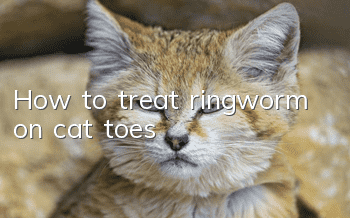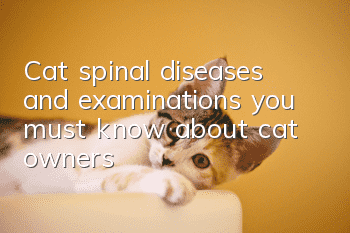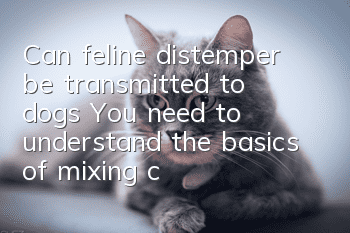Skin care rules for pet cats start with skin disease prevention

The quality of pet cat skin and hair quality all depends on the owner’s feeding method. The hair of some pet cats looks bright and shiny because the owners take more comprehensive care of them. The hair of some pet cats is darker, which may be due to insufficient nutrition. Let’s talk about the skin care rules of pet cats.
1. Skin care for pet cats starts with skin disease prevention
The greatest threat to the skin of pet cats is skin disease, and the most important skin diseases among pet cats can be divided into two types, one is parasitic disease, and the other is non-parasitic skin disease. Fleas should be the most common problem. Whether it is a cat, a dog or a person, they will be infested by fleas. This shows how serious the threat of fleas is. Once a pet cat is infected, it will itch all over its body and scratch wildly, as if it is abusing itself, which makes people itchy.
How to find traces of fleas? It’s very simple. If you find something like soot in the hair while combing your pet cat, congratulations! That’s flea droppings! If you want to get rid of this plague god, just External help is necessary. There are many flea cleaners, anti-flea collars, flea combs or insect traps on the market. These tools are all good flea removal products. In addition, the home should be kept clean at all times. In order to avoid bringing outdoor parasites into the room, clothes and shoes should be cleaned slightly when returning from the outdoors. Pet cats should also try to avoid contact with other cats with fleas.
2. Grooming pet cats
First of all, it is best to set a fixed time and steps to groom your pet cat. It is best to choose the same place, use fixed tools, fix the time of training every day, and fix the order of grooming each part of the body. Use rewards as much as possible to attract pet cats to come willingly and let you groom them. For short-haired cats, just use a short-haired metal pin comb. Gently start from the back of the pet cat's neck, then the bottom of the throat, then the chest and other parts of the body. Be careful not to irritate the abdomen, inner thighs, nipples and other areas with thin skin. The grooming time should not be too long at first. If your pet cat is scared, put the tools away first. When your pet cat starts to cooperate, remember to reward it. When combing hair, start with a comb with looser teeth, and then slowly change to a comb with denser teeth. When combing, don't comb too long at a time. Make the comb an extension of your fingers. This will make it easier for you to spot smaller tangles of hair balls before they get bigger. When you find tangles, do not wet them with water, because water will shape the hair balls and make the tangles tighter and harder to comb out.
3. What to do about folliculitis in pet cats
Folliculitis, also known as black chin, is caused by endocrine disorders. It is manifested as many small black spots on the chin, like cinders. It also occurs at the root of the tail of some cats. The root of the tail always looks dirty.It's like it can't be washed clean. Black spots on a cat's chin are not contagious, just like blackheads on a human nose. It doesn’t matter if you have a few black spots on your chin. If it becomes inflamed, hair loss, moist or smelly, it’s called folliculitis and needs treatment. The same goes for the tail. There are tail fat glands on the tail. If they are blocked, they will become inflamed, and in severe cases, they may become pus-filled. Folliculitis on the tail is more common in male cats than in female cats. Most pet cats get better after sterilization, but a few still have it after sterilization. Sometimes folliculitis also occurs on the nipples.
After a pet cat reaches the age of sexual maturity, if the sex hormones in the body are secreted too strongly, it will cause endocrine disorders in the body, and the reaction on the skin is folliculitis. This disease is more likely to occur in male cats than in female cats, and it is more common in the tail and chin. Eat cat food that is too oily. Daily cleaning is not enough. Although pet cats do not need frequent bathing, daily grooming cannot be ignored. If a pet cat's coat is knotted, oil will accumulate over time, causing folliculitis. All of the above will cause pet cats to suffer from folliculitis. Therefore, little masters must pay special attention in their daily lives.
4. Ensure pet cat nutrition
Cats are carnivorous animals and their feed is mainly meat. The quality of cat nutrition is closely related to its health status. A well-nourished cat has a strong body and strong resistance to various diseases. Malnourished cats will show symptoms at various stages of growth or reproduction. The nutritional status of female cats before and during pregnancy will directly affect the development of the fetus and the survival rate of the kittens. For example, if a newborn cat weighs less than 90 grams, it indicates that the female cat is malnourished. The nutritional level of the nursing mother cat has a greater impact on the growth and development of the kittens. In addition to breast milk, 4-week-old kittens should also take some solid feed. Kittens grow rapidly after weaning at 7 weeks of age, and the nutritional content and quantity of the feed are very important at this time. When a kitten reaches 10 to 12 weeks of age, the antibodies acquired from breast milk have disappeared. Once the kitten is nutrient deficient, it is susceptible to diseases, especially digestive system diseases and respiratory system diseases. Male cats with good nutrition and normal development reach sexual maturity at the age of 8.5 months, and when they are undernourished, they will reach sexual maturity later. Generally, female cats reach sexual maturity at the age of 7 months, but they will not be in estrus when malnourished, or they may be able to estrus and fertilize but will miscarry in the later stages of pregnancy; some even if they can barely give birth to litters, they can only be a small number of weak litters, and the survival rate is very low. Low. Therefore, the key to raising a good cat is to understand the nutritional composition and nutritional value of the feed, as well as the different needs of the cat in different growth periods, and to rationally prepare the feed to satisfy it. The nutrients in cat feed include water, protein, carbohydrates, fats, vitamins and minerals. If the nutrition keeps up, the skin health of pet cats can be more guaranteed.
Skin care for pet cats starts from an early age. The owner should prepare some better food and supplies for the cat, so that the cat can grow healthier and have more beautiful hair.
- What is missing from cats with pica? Preventing pica is better than curing it
- Is cat plague fatal?
- What should Bombay cats eat if they vomit?
- Does the orange cat recognize its owner?
- Why do many people say that fold-eared cats are difficult to raise?
- Can cats eat fried chicken skin?
- Can cats eat the kind of fish that humans eat?
- Are kittens born from close relatives necessarily unhealthy?
- The cat has white fleshy patches on its body
- What does catnip do to cats?



